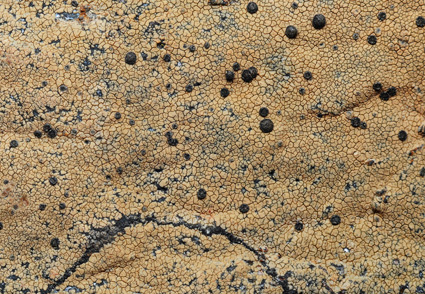Abstract
Three new saxicolous species of the lichen genus Buellia De Not. from India are described here, namely Buellia austroindica, B. subhemispherica and B. vizagensis. All the three species are characterized by an amyloid medulla and contain xanthones, connorstictic, and norstictic acid. The species B. austroindica is distinguished by its brownish yellow, rimose-areolate, UV+ pale white thallus, and orange pruina on the apothecial disc. Buellia subhemispherica is characterized by a pale grey to ivory white, rimose-areolate, UV+ orange thallus and an exciple that is aeruginose-pigmented with a paler middle layer. Buellia vizagensis is characterized by a warm white to white-grey, rimose areolate, UV+ orange thallus and yellowish brown pruina on the apothecial disc. Buellia cinnabarina and B. spuria are reported for the first time from India. Detailed descriptions, figures and distribution maps of all the species are provided.
References
- Awasthi, D.D. (1991) A key to the microlichens of India, Nepal and Sri Lanka. Bibliotheca Lichenologica 40: 1–337.
- Bungartz, F. & Nash III, T.H. (2004a) The Buellia aethalea-group in the Greater Sonoran Desert Region with reference to similar species in North America. The Bryologist 107 (4): 441–458. https://doi.org/10.1639/0007-2745(2004)107[441:TBAITG]2.0.CO;2
- Bungartz, F. & Nash III, T.H. (2004b) Buellia subalbula (Nyl.) Mull. Arg. and B. amabilis de Lesd., two species from North America with one-septate ascospores: A comparison with Buellia [“Diplotomma”] venusta (Korb.) Lettau. Bibliotheca Lichenologica 88: 49–66.
- Bungartz, F. (2004) New and previously unrecorded saxicolous species of Buellia sl with one-septate ascospores from the Greater Sonoran Desert Region. Mycotaxon 90 (1): 81–123.
- Bungartz, F., Nordin, A. & Grube, M. (2007) Buellia. In: Nash III, T.H., Gries, C. & Bungartz, F. (eds.) Lichen Flora of the Greater Sonoran Desert Region. Vol 3. Lichens Unlimited, Arizona State University, Tempe, pp. 113–179.
- Choisy, M. (1950) Catalogue des lichens de la region Lyonnaise. Bulletin de la Société Linnenne de Lyon 19: 9–24. https://doi.org/10.3406/linly.1950.7273
- de Lesdain, B.M. (1929) Lichens du Mexique. Deuxième Supplément. Lichens recueilles par le Frére Amable St. Pierre. Annales de Cryptrogamie Exotique 2: 217–254.
- De Notaris, G. (1846) Frammenti lichenographici di un lavoro inedito. Parlatore, Giornale Botanico Italiano 2: 174–224.
- Elix, J.A. & Mayrhofer, H. (2016) Two new species of Buellia sens. lat. (Ascomycota, Physciaceae) from New Zealand with 1-septate ascospores. Australasian Lichenology 79: 10–15.
- Elix, J.A. (2016) Seven new species of Buellia sens. lat. (Ascomycota, Physciaceae) from southern mainland Australia. Australasian Lichenology 78: 32–45.
- Elix, J.A. (2022) A Catalogue of Standardized Chromatographic Data and Biosynthetic Relationships for Lichen Substances. Sixth Edition. Published by the author, Canberra.
- Elix, J.A. & Mayrhofer, H. (2019) A new species of Buellia (Caliciaceae, Ascomycota) from Île Matthew, New Caledonia. Australasian Lichenology 85: 40–42.
- Flotow, J. von (1849) Lichenes florae silesiae. Fahresbericht der Schlesischen Gesellschaft Für Vaterländische Kultur 27: 98–135
- Grube, U., Mayrhofer, H. & Elix, J.A. (2004) Two new Buellia species (Physciaceae, Lecanorales) with red pigments from Australia. Bibliotheca Lichenologica 88: 163–173.
- Joshi, Y., Wang, X.Y., Lökös, L., Koh, Y.J. & Hur, J.S. (2010) Notes on Lichen Genus Buellia De Not. (lichenized Ascomycetes) from South Korea. Mycobiology 38 (1): 65–69.
- Mackay, J.T. (1836) Flora Hibernica, Vol. 2. William Curry, Inn and Co., Dublin. 279 pp.
- Marbach, B. (2000) Corticole und lignicole Arten der Flechtengattung Buellia sensu lato in den Subtropen und Tropen. Bibliotheca Lichenologica 74: 1–384.
- McCarthy, P.M. (2023) Checklist of the Lichens of Australia and its Island Territories. Australian Biological Resources Study, Canberra, version 7 March 2023. Available from: http://www.anbg.gov.au/abrs/lichenlist/introduction.html/ (accessed 1 June 2024)
- Mudd, W. (1861) A Manual of British Lichens: Containing Descriptions of All the Species and Varieties. Harrison Penney, Darlington, UK. 309 pp.
- Nordin, A. & Tibell, L. (2005) Additional species in Tetramelas. The Lichenologist 37: 491–498. https://doi.org/10.1017/S0024282905015434
- Norman, J.M. (1852) Conatus praemissus redactionis novae generum nonnullorum lichenum in organis fructificationis vel sporis fundatae. Nytt Magazin Naturvidenskapene 7: 213–252.
- Orange, A., James, P.W. & White, F.J. (2001) Microchemical Methods for the Identification of Lichens. British Lichen Society, London, UK. 101 pp.
- Prieto, M. & Wedin, M. (2017) Phylogeny, taxonomy and diversification events in the Caliciaceae. Fungal Diversity 82: 221–238. https://doi.org/10.1007/s13225-016-0372-y
- Scheidegger, C. (1993) A revision of European saxicolous species of the genus Buellia de Not. and formerly included genera. The Lichenologist 25 (4): 315–364. https://doi.org/10.1006/lich.1993.1001
- Singh, S.R. & Awasthi, D.D. (1981) The lichen genus Buellia in India. Biological Memoirs 6: 169–196.
- Tuckerman, E. (1858) Supplement to an Enumeration of North American Lichenes. The American Journal of Science and Arts 25: 422–430.
- Tuckerman, E. (1868) Lichenes. Proceedings of the American Academy of Arts and Sciences 7: 223–234.
- Tuckerman, E. (1888) A synopsis of North American lichens Part II, comprising the Lecideacei, and (in part) the Graphidacei. E. Anthony & Sons, New Bedford, MA. 176 pp. https://doi.org/10.5962/bhl.title.46052
- Vobis, G. & Hawksworth, D.L. (1981) Conidial lichen-forming fungi. In: Cole, G.T. & Kendrick, B. (eds.) Biology of conidial fungi, Vol 1. Academic Press, New York, pp. 245–273. https://doi.org/10.1016/B978-0-12-179501-6.50016-8
- Wang, X.Y., Li, L.J., Liu, D., Zhang, Y.Y., Yin, A.C., Zhong, Q.Y., Wang, S.Q. & Wang, L.S. (2020) Two new species and six new records of Buellia s.l. (lichenized Ascomycota, Caliciaceae) from China. The Bryologist 123 (3): 431–443. https://doi.org/10.1639/0007-2745-123.3.430
- Weber, W.A. (1986) The lichen flora of Galapagos Islands, Ecuador. Mycotaxon 27: 451–497.
- White, F.J. & James, P.W. (1985) A new guide to microchemical techniques for the identification of lichen substances. British Lichen Society Bulletin 57: 1–41.


